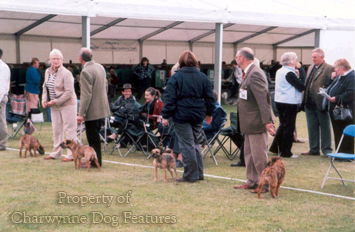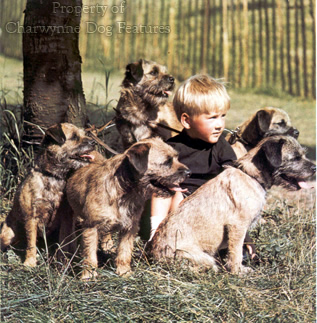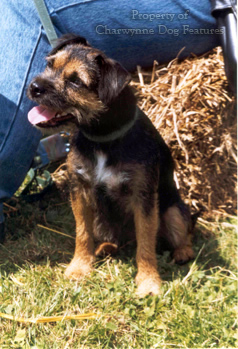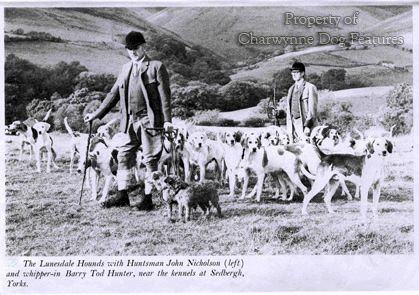757 BRINGING ON THE BORDER TERRIER
BRINGING ON THE BORDER TERRIER
by David Hancock
 Of all our native breeds of terrier, the Border Terrier’s face alone tells you reams about terrier spirit, earth-dog determination and that ‘varminty’ attitude that marks out this admirable group of sporting dogs. The popularity of this game little terrier breed puts it at the top of terrier registrations with the Kennel Club, along with the Staffordshire Bull Terrier, both totalling well over 8,000 a year. The Border Terrier has just about doubled its numbers of registered dogs in a decade, thoroughly deserved popularity. This is in stark contrast with some other sporting terrier breeds, Sealyhams, Skyes and Glen of Imaals attracting less than 100 a year and Dandie Dinmont, Smooth Fox, Norwich and Manchester Terriers achieving less than 200 a year. Those who work their terriers have long had strong views about the breed however.
Of all our native breeds of terrier, the Border Terrier’s face alone tells you reams about terrier spirit, earth-dog determination and that ‘varminty’ attitude that marks out this admirable group of sporting dogs. The popularity of this game little terrier breed puts it at the top of terrier registrations with the Kennel Club, along with the Staffordshire Bull Terrier, both totalling well over 8,000 a year. The Border Terrier has just about doubled its numbers of registered dogs in a decade, thoroughly deserved popularity. This is in stark contrast with some other sporting terrier breeds, Sealyhams, Skyes and Glen of Imaals attracting less than 100 a year and Dandie Dinmont, Smooth Fox, Norwich and Manchester Terriers achieving less than 200 a year. Those who work their terriers have long had strong views about the breed however. 
In his informative book Working Terriers of 1948, Dan Russell writes: “I know that I am standing up to be shot at when I say that I believe that the qualities I have detailed are more often found in the Border Terrier than in any other breed. To me, these little northerners are the ideal terriers. They are dead game, they have stamina, nose and endurance, and their little heads seem to be packed full of commonsense. There is in the expression of a Border Terrier an implacable determination which is seen in no other breed.” From such a source that is some praise. But others have claimed that the Border, together with that other distinguished northern terrier, the Lakeland, is too hard a terrier, just too tenacious, often being unavailable for work because of injuries sustained in needless combat. 
In his book Hunt and Working Terriers of 1931, Jocelyn Lucas writes of the Border Terrier: “Many Masters of hounds say that they are too hard, or apt to become so, killing their fox instead of bolting him. That this is sometimes the case is not unlikely, for it must be remembered that in the Fell and Border countries it is often necessary to kill foxes by any means possible.” That explanation also explains how terrain and its specific challenges lead to the need for a responding capability from the sporting dogs deployed there. At the end of this book, there is a list of the terrier breeds employed by the various hunts at the end of the 1929 season; the Border Terrier, by name if not always by type, is the choice of many. Even as assiduous a researcher as the late Brian Plummer admitted: “As with all northern breeds of working terrier, the origin of the Border Terrier is obscure though there has been much speculation as to how the breed was first developed out of the heterogeneous mish-mash of types that spawned not only the Border, but also the Dandie, the Bedlington and possibly the Lakeland terrier.” In varying degrees they share the same genes and characteristics.
Nowadays we relate to breeds far more than our sporting ancestors; breed purity was never a requirement for a working terrier, performance was all. The types favoured by terrier-men were proven workers, judged not on coat-colour or texture, height at shoulder or shape of skull and often from mixed ancestry. As Richard Clapham wrote in his Foxes, Foxhounds and Fox-Hunting, (Heath Cranton Ltd), of seventy years ago:
“Some of the best all-round working terriers today are to be found with the fell foxhound packs in the Lake District. They are practically all cross-bred, with Bedlington, Border, etc., blood in them…in the land of the dales and the mountains the only criterion of a terrier is working ability, first, last and all the time.”
Concern has been recently expressed over the KC’s willingness to register blacks and brindles as Border Terriers, but for sportsmen coat colour is never a problem. I have heard terrier-men using this breed declare that the red-nosed ones were the keenest scented. In the United States, Border Terriers earn around 114 earth-dog titles every year, more than any other terrier breed. Worryingly, show ring judges in 2011 found alarming faults in their entry, one stating “I feel that the popularity of the breed has affected the quality and the working ability of the breed in general.” Faults reported ranged from straight stifles, loose front action, too wide a front, a roaching over the loins and a poor shoulder angulation to ‘pathetically weak teeth’, flat feet and snipy jaws. Some show breeders are clearly not honouring the breed’s working past - in the most demanding country. Wherever they were used and whatever their title, this distinguished terrier breed earned praise from the right quarters.
 A correspondent to The Field magazine in 1886 wrote: “The dormant spirit of an old fell hunter has recently been keenly awakened at the mention of the Elterwater terriers, which breed, I am informed, is nearly extinct…The Elterwater terriers had plenty of go in them, and no shaking or trembling at your heels, infrost and snow, like so many of the terriers of the present day.” Elterwater is near Rydal, just north of Lake Windermere, Patterdale is some ten miles south of Rydal, at the southern end of Ullswater. Eighty years ago, the Eskdale and Ennerdale Hunt was using six couples of working Fox Terriers, whilst the Coniston Hunt was using the Fell type. The Border Terrier, also called the Reedwater Terrier, the Cheviot Terrier, the Ullswater Terrier (even Joe Bowman’s terrier) and the Robson Terrier (after the Master of the Border Hunt) was favoured by the North Tyne Foxhounds. As always with terriers, their devotees have the firmest of views about the best type for the task they undertake in their hunt country; this is how these remarkable terrier breeds came to be handed down to us and we should respect that sporting heritage, striving to perpetuate those working attributes that gave us the breed.
A correspondent to The Field magazine in 1886 wrote: “The dormant spirit of an old fell hunter has recently been keenly awakened at the mention of the Elterwater terriers, which breed, I am informed, is nearly extinct…The Elterwater terriers had plenty of go in them, and no shaking or trembling at your heels, infrost and snow, like so many of the terriers of the present day.” Elterwater is near Rydal, just north of Lake Windermere, Patterdale is some ten miles south of Rydal, at the southern end of Ullswater. Eighty years ago, the Eskdale and Ennerdale Hunt was using six couples of working Fox Terriers, whilst the Coniston Hunt was using the Fell type. The Border Terrier, also called the Reedwater Terrier, the Cheviot Terrier, the Ullswater Terrier (even Joe Bowman’s terrier) and the Robson Terrier (after the Master of the Border Hunt) was favoured by the North Tyne Foxhounds. As always with terriers, their devotees have the firmest of views about the best type for the task they undertake in their hunt country; this is how these remarkable terrier breeds came to be handed down to us and we should respect that sporting heritage, striving to perpetuate those working attributes that gave us the breed.